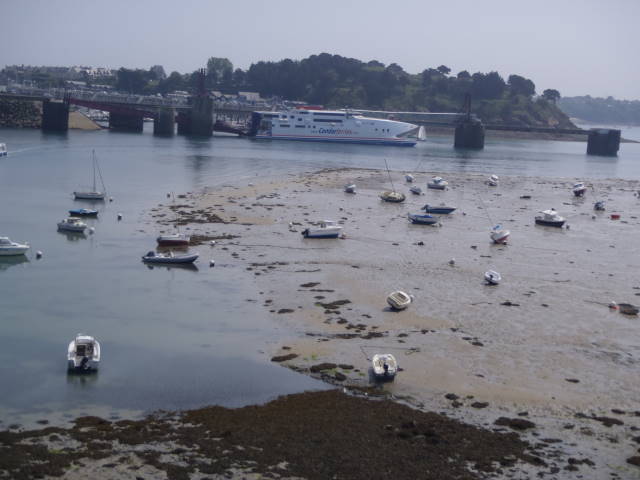St. Malo..Brittany.. with Celtic and Pirate connections!

So...first...how to get off the boat! The top of the wall is a full 5 feet above our deck, with no ladder or other means to get up except "scaling the wall"...and that was not on our agenda. We dug deep into the lazarette and pulled out the ladder we use to get into the dinghy when we are snorkeling...and..."walla", as the French say...we created our own ladder to walk up the wall. For the 3 nights and 2 days we were here it worked great! (see Picture #1 below). Looking away from the wall, we are in a dense packed marina that does not change with tide and actually sets its level by the highest tide seen in the year (Picture #2, "Arbella" is the tallest white mast on the left of the photo). St. Malo has the highest tides in Europe at 13 meters, or, about 42 feet in spring and fall! The walled city is just charming, and has a very interesting history (Picture #3 is somewhat typical). It is a walled port city in Brittany, in the northwest of France, on the English Channel. Early in our walking around, talking with locals during lunch, and doing an audio-self-guided tour, we came to realize two special connections...Celtic and Pirates, the two not really related. We never quite got a full explanation of the Celtic connection, although this runs throughout Brittany, but the flag, our new book of St. Malo Celtic legends, and a prominent Irish pub gave some evidence and stories (Picture #4). We enjoyed wonderful seafood lunches (our main meal), beautiful weather, and lots of walking within the walled city...and maybe a glass of wine or two! French trivia: St. Malo is the only city in France allowed to fly the City flag above the French flag, because between 1490 and 1493 they declared and retained their independence from France (Castle section of the Walled City in Picture #5, and from the top of the wall Picture #6). In the 1700 and early 1800's, St. Malo was home to many "privateers, also known as corsairs"....these were sailors authorized by the King to "take" English and later Dutch ships, and keep most of the spoils, turning a small portion over to the King. Of course, when their "letters of authorization" expired, or were withdrawn for not paying up, they continued to "take" the ships, but they were now "pirates" and subject to being hung if caught. We came to understand how the trading among privateers was very organized and civilized as a legal black market of sorts, but the "pirates" gave rise to more interesting stories, and they wore cool clothes, neat hats and eye patches! On the morning of May 25, we cautiously backed down our lane and prepared to leave with the high tide opening of the lock. All was fine, until a 120 foot square rigger (tourist ship), the "Belem", came up behind us, also intending to use the lock. We gave way to their bigger and less maneuverable size, and then barely fit into the lock with her...at least this time, there was no fog and we knew how the process worked (and were ready for the "monkey ball" and line to be thrown). Once clear of the shallow waters (Picture # 7, taken from the wall of the city....this is the area we circled in dense fog on the way in, not even clear where the lock entrance was..it is to the left of the adjacent area in Picture #8, although not clearly visible...and this is taken near low tide...when we went in and came out, the water was within 5 feet of the top of the wall). With a 10 hour passage back to Guernsey, and great weather, we did some real sailing. The highlight was about 1/2 way back when we were all of a sudden crossing paths with the square rigger...so we put up all sails (main, genoa, and staysail...no engine) and sailed parallel to her, but "beating her" by over 2 knots...left her in our wake!. The tourists on "Belem" were taking pictures of "Arbella" as feverishly as we were taking pictures of "Belem"...it was great fun! (Picture #9). And then an hour later, we had 8 dolphins come alongside for about 40 minutes, jumping in the side wakes and waves (Picture #10...hard to catch them out of the water). Great fun for 2 days, great people, interesting history...the Irish influence is, indeed, widespread...or so we tell ourselves! Slainte! Mike |









